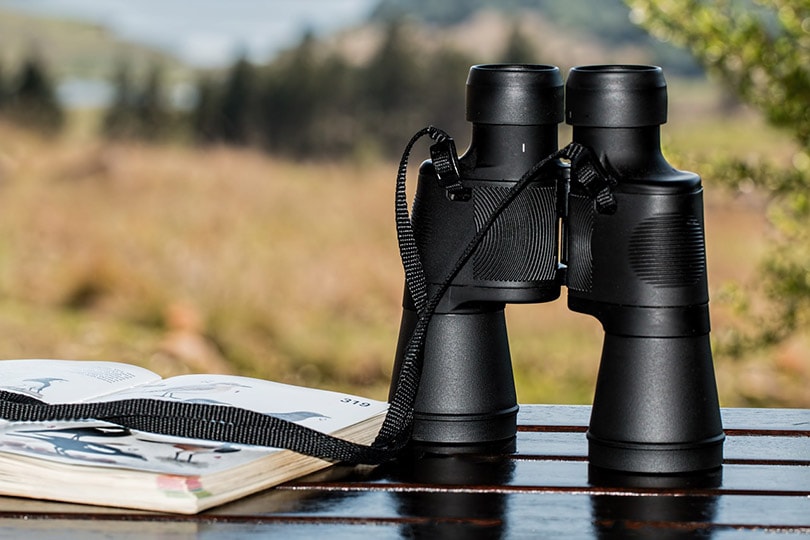When Were Binoculars Invented? History, Today & Future
Last Updated on

Binoculars, the optical instrument that magnifies distant objects and allows us to view them in incredible clarity, were invented in the early 17th century. But to get a complete history of binoculars, we need to break them down across a few key eras.
So, let’s delve into the development of binoculars throughout these periods and explore how they have evolved over time. As you’ll soon see for yourself, these handy tools required much improvement to get the binoculars we know and love today.

The Dawn of Binoculars: 1600s
The invention of binoculars can be traced back to the early 17th century, shortly after the creation of the telescope by Dutch mathematician and astronomer Hans Lippershey in 1608. Lippershey’s invention inspired others to experiment with optical devices, including Italian astronomer Galileo Galilei and German astronomer Johannes Kepler.
In 1609, Galileo created his own version of the telescope, known as the Galilean telescope. This design used a convex objective lens and a concave eyepiece, which resulted in an upright image. Despite its limitations, the Galilean telescope laid the foundation for the development of binoculars.
The first true binoculars were invented in 1609–1610 by an Italian mathematician, Cherubin d’Orleans. He constructed a pair of Galilean telescopes and mounted them side by side to create binocular vision. However, his invention was far from perfect and did not gain much popularity.

Refining the Design: 1800s
The 19th century witnessed significant advancements in the development of binoculars. In 1823, J.P. Lemiere, a French optician, invented the first binocular telescope. This invention marked a significant milestone in the development of binoculars, as it improved image quality and allowed for a more compact design.
In 1854, Ignazio Porro, an Italian inventor, created the Porro prism system, which used a pair of prisms to fold the light path and correct the image orientation in binoculars. His invention marked the beginning of the modern binocular era.
Subsequently, several companies and inventors began producing binoculars using Porro’s design, including Carl Zeiss and Ernst Abbe, who together founded the Zeiss company in Germany.

The 20th Century: Mass Production & Technological Advancements
The 20th century saw a boom in the production and development of binoculars thanks to technological advancements and growing demand. The two World Wars played a significant role in the increased demand for binoculars, as they became essential tools for military reconnaissance and surveillance.
During this period, binoculars were continuously improved to meet the needs of various applications. For instance, the introduction of roof prisms in the early 1900s allowed for a more streamlined design, which was especially useful for military purposes.
In addition, advancements in optical coatings significantly enhanced light transmission and reduced glare, providing brighter and clearer images.
In the latter half of the 20th century, binoculars began incorporating electronic components, such as rangefinders, compasses, and image stabilizers. These features further expanded the capabilities of binoculars, making them suitable for a wide range of professional and recreational activities.

Modern Binoculars: 2000s & Beyond
The 21st century has witnessed further advancements in binocular technology, with innovations focusing on improving user experience and making them more versatile. Some of these advancements include:
Waterproof and Fog-Proof Binoculars: Modern binoculars often feature sealed and nitrogen-purged designs, ensuring that they remain fog-free and waterproof, making them suitable for use in harsh weather conditions and marine environments.
Lightweight Materials: The use of lightweight materials, such as polycarbonate and magnesium alloy, has made modern binoculars more comfortable to hold and carry, especially for extended periods.
Advanced Optical Coatings: Modern binoculars feature advanced lens coatings that further improve light transmission, reduce glare, and enhance color fidelity, providing users with sharper, brighter, and more vivid images.
Digital Binoculars: The integration of digital technology in binoculars allows users to capture images, videos, and even connect to smartphones or tablets for sharing or further editing.
Night Vision and Thermal Imaging: These technologies have been incorporated into binoculars, allowing users to see in low light conditions and even detect heat signatures, expanding the range of applications and making them invaluable tools for wildlife observation, search and rescue, and military operations.
What do you think the future holds for our beloved binoculars? Perhaps you could be the next great inventor who improves on this invaluable tool!


Conclusion
The invention of binoculars in the early 17th century marked the beginning of a fascinating journey of technological advancements and innovations. Over the centuries, binoculars have gone from rudimentary optical instruments to highly sophisticated and versatile tools, catering to various professional and recreational needs.
As technology continues to advance, we can expect further improvements in binocular design and functionality, making them even more indispensable in our lives!
Featured Image Credit: Kaitlin Duffey, Unsplash
About the Author Robert Sparks
Robert’s obsession with all things optical started early in life, when his optician father would bring home prototypes for Robert to play with. Nowadays, Robert is dedicated to helping others find the right optics for their needs. His hobbies include astronomy, astrophysics, and model building. Originally from Newark, NJ, he resides in Santa Fe, New Mexico, where the nighttime skies are filled with glittering stars.
Related Articles:
How to Collimate Binoculars: 9 Expert Tips
Binocular Magnification Chart: Numbers & Distances Compared
What Is the Best Binocular Magnification for Hunting? Optical Features Explained
Can You Use Binoculars to Look At Stars? How to Choose the Right Pair
How to Choose Binoculars for Bird Watching: 10 Expert Tips
What Does 20X50 Mean on Binoculars? Our Helpful Guide
10 Best Binoculars in Canada of 2024: Reviews & Top Picks
Infrared Binoculars vs. Night Vision: Which Should I Choose?
